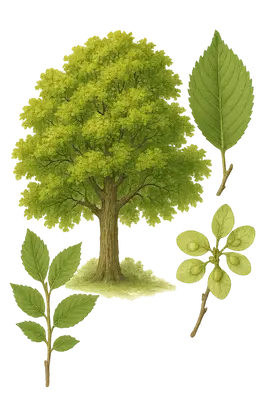Elm (Tree)
Description
Elm trees (Ulmus species) are deciduous trees known for their distinctive vase-shaped canopy and serrated leaves with asymmetrical bases. There are approximately 35 species of elm, native to temperate regions across North America, Europe, and Asia. Elms have historically been popular as street and park trees due to their graceful form and dense shade, though many populations have been devastated by Dutch elm disease. Common species include American elm (Ulmus americana), English elm (Ulmus procera), and Chinese elm (Ulmus parvifolia).

Allergy Symptoms
Elm pollen commonly causes:
- Sneezing and runny or congested nose
- Itchy, watery, and red eyes
- Coughing and throat irritation
- Wheezing and exacerbation of asthma symptoms
Some individuals with elm pollen allergies may experience Oral Allergy Syndrome (OAS), causing itching or tingling of the mouth and throat when consuming certain raw fruits such as apples, peaches, and cherries due to cross-reactive proteins. Cooking these foods typically reduces or eliminates the allergic reaction.
Typical Pollination Period
The pollination period for elm trees varies by species and location:
- Spring-blooming elms: Many species release pollen from late winter to early spring, typically between February and April, with peak levels in March
- Fall-blooming elms: Some species, such as Chinese elm (Ulmus parvifolia), pollinate in late summer to early fall, potentially extending allergy symptoms into November
Geographic Distribution
Elm trees are widely distributed across the Northern Hemisphere:
- North America: American elm and other species are prevalent throughout the United States and Canada
- Europe: English elm and field elm are common across the continent
- Asia: Various species are found in temperate regions including China, Japan, and Southeast Asia
Tips for Reducing Exposure and Managing Allergies
- Monitor local pollen forecasts and limit outdoor activities during high pollen days
- Keep windows closed and use air purifiers with HEPA filters indoors
- Shower and change clothes after spending time outdoors
- Use antihistamines or nasal corticosteroids as recommended by a healthcare professional
- Be aware that some elm species pollinate in fall, not just spring
- Consider allergy testing and immunotherapy for persistent or severe symptoms